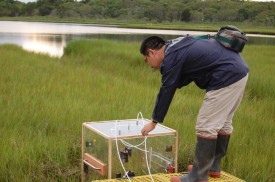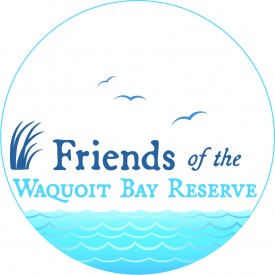Efficacy of established and emerging tidal marsh restoration methods
Project Title: Efficacy of established and emerging tidal marsh restoration methods
Lead Investigator: Brian Yellen, UMass Amherst, byellen@umass.edu
Onsite Contact: Sintra Reves-Sohn, UMass Amherst, srevessohn@umass.edu
Project Description: Salt marshes are extremely beneficial to surrounding communities because they provide recreational spaces, control floods, and improve water quality. Salt marshes also effectively store carbon and are home to resident species, such as the endangered saltmarsh sparrow and commercially and culturally important fish stocks. Vegetation is key to salt marsh survival; when the marsh is flooded at high tide, salt marsh vegetation traps sand and mud, which makes it possible for the salt marsh to build upward. This is especially important for salt marsh survival when sea level is rising quickly. If the marsh can’t build elevation, it will be outrun by rising sea levels. In addition to the threat of sea level rise, the Dog’s Head Marsh at Waquoit Bay National Estuarine Research Reserve is vulnerable due to an undersized culvert that was removed in 2008. Pre-removal, the culvert prevented tides from traveling far upstream, causing the once salty ecosystem to “freshen,” which in turn causes the land to subside (become low in elevation). When the culvert was removed in 2008, saltwater flooded this upstream area, which caused the freshwater vegetation to die, and creating a muddy expanse. The aim of this project is to characterize how sediment is moving through Sage Lot Pond and into Dog’s Head Marsh at WBNERR and understand how this relates to how Dog’s Head Marsh’s vegetation has adapted post-culvert removal. With this information, we can better predict how Dog’s Head Marsh will continue to adapt to rising sea level and we can make recommendations to how to best preserve the salt marsh.
salty ecosystem to “freshen,” which in turn causes the land to subside (become low in elevation). When the culvert was removed in 2008, saltwater flooded this upstream area, which caused the freshwater vegetation to die, and creating a muddy expanse. The aim of this project is to characterize how sediment is moving through Sage Lot Pond and into Dog’s Head Marsh at WBNERR and understand how this relates to how Dog’s Head Marsh’s vegetation has adapted post-culvert removal. With this information, we can better predict how Dog’s Head Marsh will continue to adapt to rising sea level and we can make recommendations to how to best preserve the salt marsh.
A Fetch Dependent Gas Transfer Velocity
Project Title: A Fetch Dependent Gas Transfer Velocity
Year: 2020
Principal Investigators: Seth Zippel (AOPE) (szippel@whoi.edu) and Matthew Long (MCG)
Affiliations: Woods Hole Oceanographic Institution
Abstract: Air/water exchanges of gasses are important for both local biogeochemical cycles and for large scale climate change. Typically, these gas exchanges are parameterized as a function of wind speed without any direct consideration of the local turbulence or surface waves that are physically relevant to these transfers. As such, these parameterizations fail in coastal areas where waves are limited by fetch and modified by local currents and bathymetry. We propose a fetch-dependent gas transfer velocity based on existing theory for near surface turbulence and wave growth. We propose to test this new parameterization with local measurements in Waquoit Bay under a range of fetch and wind speeds. This parameterization will help the biogeochemical community estimate gas fluxes with simple inputs (locally measured wind speed and fetch from Google maps) without a need for measurements of complex turbulent dynamics. With increasing attention to the large role that coastal and estuarine environments play in global biogeochemical cycling, there is a growing consensus that better estimates of air/water exchange are needed to accurately describe their importance, as well as how this may be altered due to local anthropogenic influence and global climate change.
Greenhouse Gas Measurement at Sage Lot
Project Title: Greenhouse Gas Measurement at Sage Lot
Date: 5/2018-12/2018
Principal Investigator(s): Dr. Jim Tang, Dr. Faming Wang
Affiliations: MBL
Summary: In this study, we continued the field gas flux measurements at Sage lot salt marsh. We installed 4-inch diameter collars for soil respiration measurement, and big collar (20 inch) for the ecosystem level measurements. We installed warming chambers to heat the marsh to mimic the warming effect and measure the response of greenhouse gas fluxes to warming. The aim of this study is to measure CO2 and CH4 fluxes in the pristine salt marsh, and support our project to study New England Salt marsh blue carbon.
Spatial variability of carbon export from tidal marsh drainage
Project Title: Spatial variability of carbon export from tidal marsh drainage
Date: 11/2018-8/2019
Principal Investigator(s): Joseph Tamborski
Affiliations: Woods Hole Oceanographic Institution
Summary: Salt marshes provide significant environmental and economic value by shielding coastal communities against storm-surges and sequestering CO2 from the atmosphere, acting as a natural buffer to climate change. Carbon is both buried by marsh plants and exported to the coastal ocean from tidal drainage. However, the spatial variability of carbon export from tidal drainage across a salt marsh platform is largely unknown. Our two main objectives are to [1] characterize salt marsh hydrology under present and future climate scenarios; and [2] to determine the spatial and temporal variability of carbon export from tidal marsh drainage. Sediment cores, marsh pore waters and vertical temperature profiles will be sampled across marsh platforms, toward the tidal creek, to help reveal spatial patterns in seasonal exchange fluxes. Hydrogeological models will be used to assess salt marsh resiliency to changing climate scenarios. These tasks aim to reveal how salt marshes impact carbon cycling and biogeochemistry of the Northwest Atlantic and identify the vulnerability of these critical wetlands to changing terrestrial and marine conditions.
Photochemical degradation of dissolved organic carbon at Waquoit Bay
Project Title: Photochemical degradation of dissolved organic carbon at Waquoit Bay
Date: 7/2018-7/2019
Principal Investigator(s): Collin Ward, Sam McNichol
Affiliations: WHOI
Summary: Dissolved organic carbon is a central intermediate in the global carbon cycle. For nearly fifty years we’ve known that sunlight can alter the chemical make-up of dissolved organic carbon, which changes how fast microbes respire it to carbon dioxide. However, very little is known about the rate that this coupled photochemical biological reaction occurs. In this study, we are using Waquoit Bay as a field site to test a new method to quantify photochemical biological dissolved organic carbon degradation. The facility is ideal because (i) it offers easy access to diverse water types (i.e., lake, river, groundwater, estuarine), and (ii) water quality data is continuously monitored.
Carbon dioxide fluxes reflect plant zonation and below ground biomass in a coastal marsh
Project Title: Carbon dioxide fluxes reflect plant zonation and below ground biomass in a coastal marsh
Date: 2016
Principal Investigators: Moseman‐Valtierra, S., Abdul‐Aziz, O. I., Tang, J., Ishtiaq, K. S., Morkeski, K., Mora, J., & Carey, J.
Summary: Coastal wetlands are major global carbon sinks; however, they are heterogeneous and dynamic ecosystems. To characterize spatial and temporal variability in a New England salt marsh, greenhouse gas (GHG) fluxes were compared among major plant‐defined zones during growing seasons. Carbon dioxide (CO2) and methane (CH4) fluxes were compared in two mensurative experiments during summer months (2012–2014) that included low marsh (Spartina alterniflora), high marsh (Distichlis spicata and Juncus gerardii‐dominated), invasive Phragmites australis zones, and unvegetated ponds. Read Full text…Ecosphere, 7(11). http://onlinelibrary.wiley.com/doi/10.1002/ecs2.1560/full
Sediment nitrous oxide fluxes are dominated by uptake in a temperate estuary
Project Title: Sediment nitrous oxide fluxes are dominated by uptake in a temperate estuary
Date: 2016
Principal Investigator(s): Foster, S.Q., & Fulweiler, R.W.
Summary: Coastal marine ecosystems are generally considered important sources of nitrous oxide (N2O), a powerful greenhouse gas and ozone depleting substance. To date most studies have focused on the environmental factors controlling N2O production although N2O uptake has been observed in a variety of coastal ecosystems. In this study, we examined sediment fluxes of N2O during 2 years (2012–2013) in a shallow temperate estuary (Waquoit Bay, MA, USA). Read full text…Frontiers in Marine Science, 3, 40. http://journal.frontiersin.org/article/10.3389/fmars.2016.00040/full
Evaluation of laser-based spectrometers for greenhouse gas flux measurements in coastal marshes
Project Title: Evaluation of laser-based spectrometers for greenhouse gas flux measurements in coastal marshes
Date: 2016
Principal Investigator(s): Brannon, E. Q., Moseman-Valtierra, S. M., Rella, C.W., Martin, R.M., Chen, X. and Tang, J.
Abstract: Precise and rapid analyses of greenhouse gases (GHGs) will advance understanding of the net climatic forcing of coastal marsh ecosystems. We examined the ability of a cavity ring down spectroscopy (CRDS) analyzer (Model G2508, Picarro) to measure carbon dioxide (CO2), methane (CH4), and nitrous oxide (N2O) fluxes in real‐time from coastal marshes through comparisons with a Shimadzu GC‐2014 (GC) in a marsh mesocosm experiment and with a similar laser‐based N2O analyzer (Model N2O/CO, Los Gatos Research) in both mesocosm and field experiments. Read full text… Limnol. Oceanogr. Methods, 14: 466–476. doi:10.1002/lom3.10105. http://onlinelibrary.wiley.com/doi/10.1002/lom3.10105/full
Potential Effects of Sea-Level Rise on the Depth to Saturated Sediments of the Sagamore and Monomoy Flow Lenses on Cape Cod, Massachusetts
Project Title: Potential Effects of Sea-Level Rise on the Depth to Saturated Sediments of the Sagamore and Monomoy Flow Lenses on Cape Cod, Massachusetts
Date: 2016
Principal Investigator(s): Bay, C.C.
Publication: In 2014, the U.S. Geological Survey, in cooperation with the Association to Preserve Cape Cod, the Cape Cod Commission, and the Massachusetts Environmental Trust, began an evaluation of the potential effects of sea-level rise on water table altitudes and depths to water on central and western Cape Cod, Massachusetts. Increases in atmospheric and oceanic temperatures arising, in part, from the release of greenhouse gases likely will result in higher sea levels globally. Read/download full text…https://pubs.usgs.gov/sir/2016/5058/sir20165058.pdf
CO2 Flux Sensor System
Anna Michel, Zoe Sandwith (WHOI)
Funding Source(s): WHOI
Flux measurements using the eddy covariance technique
Matthew Long, WHOI
Funding Source(s): WHOI
Investigating Salt Marshes as a source of Alkalinity and Low pH, High CO2 water to the Ocean
Project Title: Investigating Salt Marshes as a source of Alkalinity and Low pH, High CO2 water to the Ocean
Principal Investigators: Kevin Kroeger, Meagan Gonneea, U.S. Geological Survey: Woods Hole Coastal and Marine Science Center, Aleck Wang, WHOI
Funding Source(s): USGS, NSF
Primary Producers in the Sea
Project Title: Primary Producers in the Sea
Date: 2015
Principal Investigator: Valiela, I.
Abstract: We use the term “primary producers” to include a large variety of organisms that manufacture organic compounds, by either photosynthesis or chemosynthesis. Photosynthetic primary producers use light-derived energy to convert carbon dioxide into organic carbon compounds that are integrated into cells. Read full text…In Marine Ecological Processes (pp. 3-34). Springer New York. https://link.springer.com/chapter/10.1007/978-0-387-79070-1_1
Greenhouse gas fluxes vary between Phragmites australis and native vegetation zones in coastal wetlands along a salinity gradient
Project Title: Greenhouse gas fluxes vary between Phragmites australis and native vegetation zones in coastal wetlands along a salinity gradient
Date: 2015
Principal Investigator(s): Martin, R.M., & Moseman-Valtierra, S.
Summary: The replacement of native species by invasive Phragmites australis in coastal wetlands may impact ecosystem processes including fluxes of the greenhouse gases (GHGs) carbon dioxide (CO2) and methane (CH4). To investigate differences in daytime CH4 and CO2 fluxes as well as vegetation properties between Phragmites and native vegetation zones along a salinity gradient, fluxes were measured via cavity ringdown spectroscopy in 3 New England coastal marshes, ranging from oligohaline to polyhaline. Read full text…Wetlands, 35(6),1021-1031. https://link.springer.com/article/10.1007/s13157-015-0690-y
User Friendly Predictive Modeling of Greenhouse Gas (GHG) Fluxes and Carbon Storage in Tidal Wetlands
Project Title: User Friendly Predictive Modeling of Greenhouse Gas (GHG) Fluxes and Carbon Storage in Tidal Wetlands.
Date: 2015
Principal Investigator(s): Ishtiaq, K.S., & Abdul-Aziz, O.I.
Summary: In AGU Fall Meeting Abstracts. https://ui.adsabs.harvard.edu/abs/2015AGUFM.B21H0574I/abstract
Corrigendum: Spatial and historic variability of benthic nitrogen cycling in an anthropogenically impacted estuary
Project Title: Corrigendum: Spatial and historic variability of benthic nitrogen cycling in an anthropogenically impacted estuary
Date: 2015
Principal Investigator(s): Foster, S.Q., & Fulweiler, R.W.
Summary: The authors wish to include the following correction based on updated di-nitrogen (N2) gas flux values for three cores included in the original paper (the N2 flux values for the other 38 cores remain unchanged). This update was made in order to be consistent in our N2 flux calculations across all cores. In the three aforementioned cores we originally used a different method to account for the instrument drift of the mass spectrometer during sample analysis. Importantly, the correction of the flux values for these three cores is small and does not change any of our data interpretations. Read full text…Frontiers in Marine Science, 2, 70. http://journal.frontiersin.org/article/10.3389/fmars.2015.00070/full
In-situ ecosystem metabolism measured by eddy correlation
PI: Matthew Long, WHOI
Funding: WHOI
Greenhouse Gas Sensing in Coastal and Salt Marsh Environments
Project Title: Greenhouse Gas Sensing in Coastal and Salt Marsh Environments
Date: 2012
Principal Investigators Anna Michel, Princeton University
Funding: WHOI and submitted grants (NSF, MIT Seagrant)
The Impact of Nitrogen-loading on Salt Marsh Greenhouse Gas Fluxes
 PIs: Serena Moseman-Valtierra, University of Rhode Island, Jianwu Tang, MBL Ecosystems Center, Kevin Kroeger, USGS-Woods Hole Science Center,
PIs: Serena Moseman-Valtierra, University of Rhode Island, Jianwu Tang, MBL Ecosystems Center, Kevin Kroeger, USGS-Woods Hole Science Center,
Funding: MIT Seagrant
The general goal for the project is to measure potential greenhouse gas (GHG) emissions and net CO2 uptake in coastal wetlands under a range of realistic nitrogen (N) loads and inundation (sea) levels. By meeting this goal, we aim to improve the information with which managers and policy makers can maintain and maximize ecosystem productivity, reduce harmful feedbacks of climate, and assess the potential for these ecosystems to enter C markets.
We will examine how GHG emissions from salt marshes vary along an existing gradient of anthropogenic N loading in Waquoit Bay, MA (WB-NERR). Further, we will test for relationships between N loads to the marshes and plant productivity. To investigate the influence of anticipated future increases in sea level, we will use existing gradients in marsh soil elevation (and therefore a gradient in soil water saturation and in frequency and duration of soil inundation) as a space-for-time substitution simulating future inundation of soils.
Carbon Management in Coastal Wetlands: Quantifying Carbon Storage and Greenhouse Gas Emissions by Tidal Wetlands to Support Development of a Greenhouse Gas Protocol and Economic Assessment
Project Title: Carbon Management in Coastal Wetlands: Quantifying Carbon Storage and Greenhouse Gas Emissions by Tidal Wetlands to Support Development of a Greenhouse Gas Protocol and Economic Assessment
Project Lead: Alison Leschen, Waquoit Bay Reserve Manager
Collaborative Lead: Tonna-Marie Rogers, Waquoit Bay Coastal Training Program Coordinator
Principal Investigator(s): Jianwu Tang, MBL Ecosystems Center, Kevin Kroeger, USGS-Woods Hole Science Center, Neil K. Ganju, USGS-Woods Hole Science Center, Serena Moseman-Valtierra, University of RI, Omar Abdul-Aziz, Florida International Univ., Stephen Emmett-Mattox, Restore America’s Estuaries, Igino Emmer, Silvestrum, Stephen Crooks, Consultant to RAE, Pat Megonigal, Smithsonian ERC, Thomas Walker, Manomet CCS, Chris Weidman, Waquoit Bay Reserve Research Coordinator,
Funding: NERRS Science Collaborative
Summary: Increasing atmospheric concentrations of three major greenhouse gases (GHG) are the main drivers of climate change. Efforts to ameliorate rising levels of GHG include the protection and restoration of ecosystems that constitute major carbon (C) sinks and minor sources of CH4 and N2O emissions. Tidal marshes are prime candidates for such efforts as their sediments display high C sequestration. Loss of wetlands through human impacts such as land conversion, sediment supply disruption, nutrient loading, and with sea level rise, reduces future sequestration capacity and places at risk stores of C that built up over past centuries. Improved management of coastal C and nitrogen (N), based upon sound science, is a critical first step towards mitigation of climate change and management of coastal ecosystems. Management must address N loading that has the dual impact of 1) contributing to climate change through production of N2O, and 2) reducing production of root and soil matter by plants which can decrease the C sequestration capacity and resilience of marshes to sea level rise. Recognition of the importance of coastal marine systems in terms of C storage has led to national and international efforts to place monetary value on preserving or restoring the “blue carbon” in those systems, analogous to the value placed on forests. The barrier to incorporation of tidal wetlands into C markets is the absence of agreed upon GHG offset protocols that set guidelines for monitoring and verification requirements for wetlands projects, and a lack of data and knowledge regarding C and GHG fluxes in wetlands to support model development.
The project goals are to provide scientific information that can inform both C and N management as well as wetlands protection and restoration strategies for supporting development of policy frameworks and market-based mechanisms to reduce GHG.
Project website: https://waquoitbayreserve.org/research-monitoring/salt-marsh-carbon-project/


